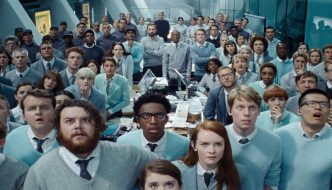
The Killing of a Sacred Deer directed by Yorgos Lanthimos, from a screenplay by Lanthimos and Efthymis Filippou, is Lanthimmos’ next film succeeding The Lobster. A psychological thriller which follows the story of Steven: his nuclear family, strange befriendment of a boy Martin, and the disarranged disfigurement which prevails his family. It feels more like a social experiment than a fictional film.
Lanthimos’ trade-mark dead-pan characters make a re-appearance in the film. The characters dialogue is completely devoid of emotion, making them all the more hard to read. Farrell’s intense blankness is intriguing, unsettling, and little shocking at first. The film is full of complex relationships between these emotionless characters, relationships which become dependant on the paradoxical symbiosis of obsession and resistance towards each other. At the early parts of the film, the relationship between Martin and Stephen, although atypical, is somewhat awkwardly charming. At this point, Martin is almost an extension of Stephen, or at least he tries to be. Yet, this relationship is soon perverted and the thriller genre is uncovered. This is something which the film constantly does; drawing it’s audience into a safe place, making them feel comfortable, and soon exploits them. One moment someone is a victim, then they become the villain. This is what makes the film all the more terrifying.
With regards to character representation, the film excels in stereotypical representation: on the nuclear family, the idealisation of doctor parents, the stereotypical association between femininity and art; masculinity and science. But, like all sense of security which encroaches the film, this is turned on it’s head. The interest Steven takes in Kim’s progression into puberty does sit uncomfortably with the audience. Mixed with the tension between Steven and his son Bob, the resentment Anna shows towards Kim, her daughter, and the object of the wife as a her husband’s muse (made all the more clear through the character she adopts in their sex scene), it is hard to not associate these character’s with Freudian reading. But I wouldn’t say this psychoanalytical reference is explicit.
All of the characters are intimidating in their own way: the ambiguity surrounding Bob, the sadistic nature of Martin, Steven’s control over his family, and the threatening sexualization of Kim. Anna, the surgeon’s wife, is the character who mostly seems to be on a mutual level with the audience. But then even there are brief moments where she is so cold; so devoid of emotion, that the audience is left wondering if she too is under the same influence as the other characters. This is where I struggle to interpret this observation as a deliberate decision made by Lanthimos; or whether it was Kidman’s portrayal of the character. She seemed slightly more emotionally conscious than the other characters, her dead-pan style seemed to come from a place of reason. Her resistance seems to come from a conscious place of irritation; not just completely lacking emotion or thought. Whether this was down to Kidman’s interpretation of the character, or of the character itself, this difference did still add a nice contrast to the other character’s.
One aspect which makes reasserts the uneasy tone in this film is the music score. With a similar style to The Lobster, Killing of a Sacred Dear takes the classical music genre and twists it to become all the more disturbing. The music shapes the tone of a sequence of shots, it acts as a warning/siren for the audience.
It is difficult to pin point any specific style of the film in terms of it’s mise-en-scene, but this doesn’t take away from the films aesthetics. If anything it is a good technique to direct the audiences vision to other aesthetic qualities: the music becomes all the more haunting, the camera angles are more pronounced, and the audience can focus on trying to unpack the complex dialogue more. The style of camera shots reflects the film’s own impersonal style: there are no close up shots, no insight into a character’s subconscious. The audience is never offered to feel what they feel. There is no softness to the camera shots. Instead, the film is overwhelmed with straight lines, with rigid angles. Yet, nothing in the film is straightforward. The cleanliness and sense of clarity is a complete deception. This cold, impersonal feel is continued. The films tone is full of cool tones: blues, making it all the more cold and yellow: reflecting the clinical, sterile hospital setting. It is a question and answer section; no emotion or love. And every question is answered so the audience are under the impression nothing is concealed. But it is an easy sense of security that appears to just be a papering over the cracks, of a much darker undertone.
Although labelled a thriller, the film isn’t fantastical in its genre classification. The film is not shocking in the sense of being gruesome: the only time you may shy away is at the end at the scene in the basement. It is the clean, slick style of the films dialogue, character movements, lightning, object placement which makes it disturbing. Any chaos in the film is controlled, like when Steven is tearing the kitchen apart.
It is a film which does not seem to have a wider message, no political or social intention. There is no context: it is a pure psychological thriller to it’s core.
Filed under: Film, TV & Tech
Tagged with: film, film review, HOME Manchester, Nicole Kidman, The killing of a sacred deer



Comments